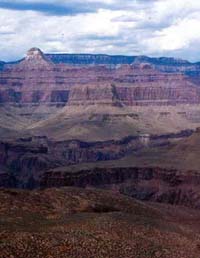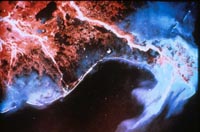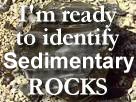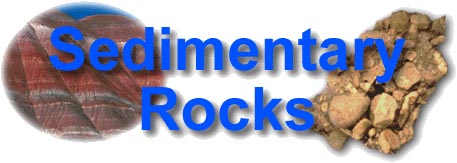
|
|
Sedimentary
Rock Identification
Singer songwriter Bob Dylan once asked in a song: "How many years
can a mountain exist before it's washed to the sea...?". What he didn't
ask is where do the rocks that the mountain were made from finally end up?
The answer "my friend" is in sedimentary rocks.
SEDIMENTARY ROCKS
Sedimentary rocks are rocks are rocks are formed by materials that
have been derived by the processes of weathering and erosion from other,
pre-existing rocks at the Earth's surface. Sedimentary rocks make up only
about 5% of the Earth's lithosphere, but they are concentrated
near the surface and actually represent about 75% of those rocks
exposed at the surface. The physical characteristics (grains,
crystals and cements) and fossils of sediments and sedimentary
rocks provide an important record of Earth history. The physical
make up of these rocks provides many clues as to where and how
the rocks may have formed. Fossils, which represent the traces
or remains of prehistoric life preserved in sedimentary rocks,
allow us to study the history of life on Earth. Sedimentary
rocks also have important commercial value as a source of
petroleum, ground water, building materials, and economically valuable mineral deposits such as aluminum, gold, iron and others.
FORMATION OF SEDIMENTS
The materials that represent sediments are derived from
weathering and erosion of pre-existing igneous, metamorphic and
sedimentary rocks wherever they are exposed at the Earth's
surface. This weathered material is transported by ice, wind,
and primarily water to a site of deposition, such as a lake or
ocean. Evidence of this transportation can be seen whenever it
rains; water in the streams and rivers turns brown because of
all the sediments they are carrying.
The sediments produced by these activities are most commonly deposited as layers in bodies of water,
and most tend to form in the oceans. For
example, the
 Mississippi River empties into the Gulf of Mexico
and has formed a huge sedimentary delta. After deposition and
burial other processes act on these sediments and result in
their
lithification (processes of compaction or cementation) into
sedimentary rocks. A well known region for
exposures of distinctly layered sedimentary rocks is Grand
Canyon National Park in Arizona, but this layering
can be observed almost anywhere that sedimentary rocks are
exposed at the surface. Mississippi River empties into the Gulf of Mexico
and has formed a huge sedimentary delta. After deposition and
burial other processes act on these sediments and result in
their
lithification (processes of compaction or cementation) into
sedimentary rocks. A well known region for
exposures of distinctly layered sedimentary rocks is Grand
Canyon National Park in Arizona, but this layering
can be observed almost anywhere that sedimentary rocks are
exposed at the surface.
Weathering at the Earth's surface provides the basic material
for the formation of sedimentary rocks. There are two main
weathering processes: mechanical weathering (also called physical weathering)
and chemical weathering. Mechanical weathering is the physical
process that breaks down rocks (examples would be freezing and
thawing of ice, or abrasion due to water, wind and ice).
This process results in the formation of small fragments called
clasts. When these clasts are deposited elsewhere and lithified
into sedimentary rocks, we have a class of sedimentary rocks
known as
Clastic Sedimentary Rocks. Chemical weathering involves the disintegration of the
minerals in rocks by chemical reactions as a result of exposure
to
air and water. In this case the preexisting rocks dissolve in
the aqueous solution. If the conditions are right, that
dissolved material may precipitate out forming the second class
of sedimentary rocks known as Chemical
Sedimentary Rocks.
Now you are ready to identify some common sedimentary rocks. Let's get started!

|

